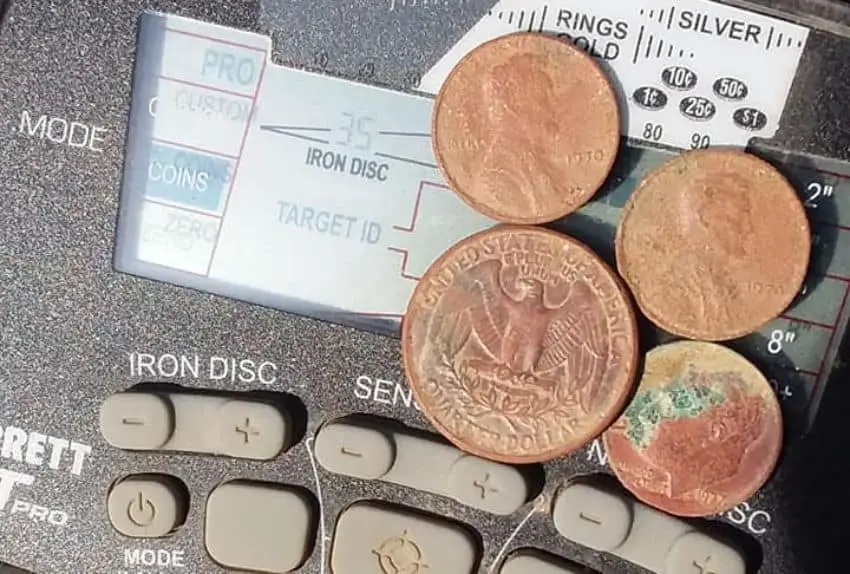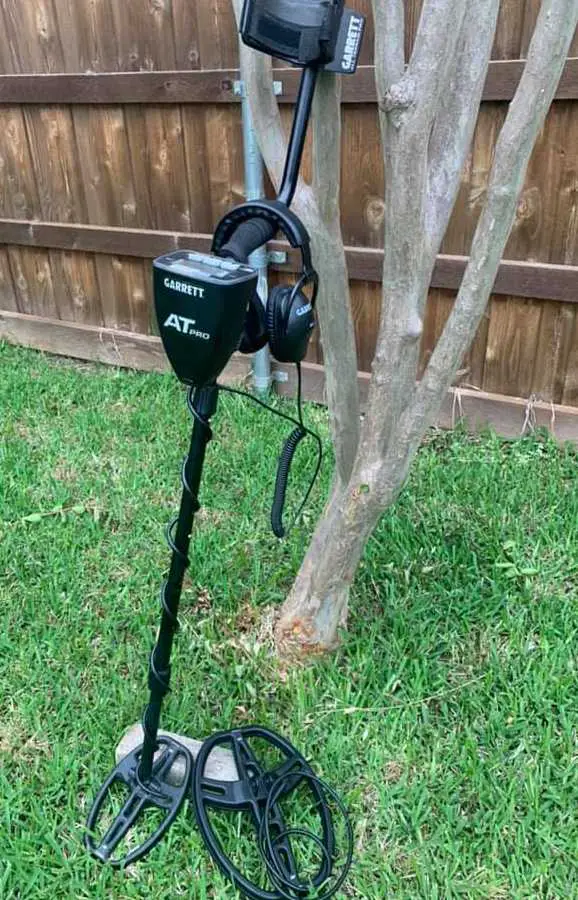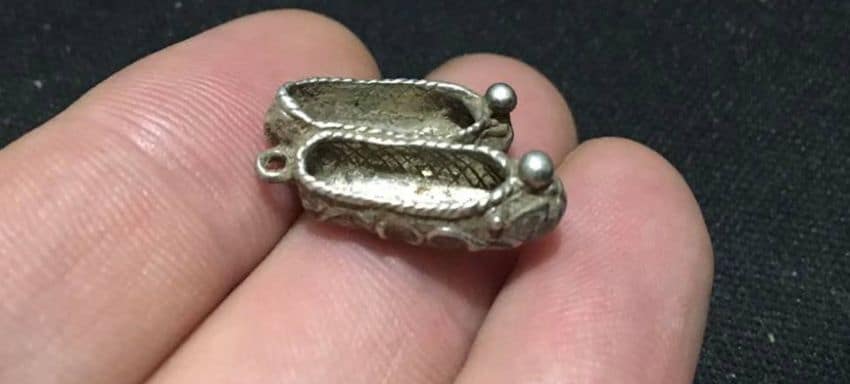
While swinging a metal detector I understand that everyone, including me, is generally expecting highly valuable targets such us Gold or antique relics … However, there are other worthwhile metals that you can certainly focus on and still get good value from them such as Silver …
… But, can metal detectors detect silver? Yes! Among all known metals out there, pure silver has the highest electrical conductivity of all. And since detectors reacts mainly to elements that are conductive electrically, it will be able to pick it up very easily. You will even be able to read in your VDI screen the highest numbers possible.
In this article, I dive deep into this subject by providing you the tools you should be using to pick up this metal quite often. Plus, the different kinds of silver finds you should generally expect and how valuable they could be.
Best metal detector for silver in general!

To be honest, most detectors have the ability to find silver since it is highly conductive. Yet, I still think that the Garrett AT Pro (Check it Here at Amazon) is a great choice.
This is a VLF (very low frequency) model designed to serve all-purposes when it comes to possible targets.
The 2 main challenges that come with silver are the surrounding trash and the potential depth you might be dealing with.
And since it has a 8.5″ x 11″ DD PROformance coil that provides a good target separation with a decent depth then these 2 constraints won’t be that much of an issue.
You can integrate it with other coil dimensions if you want to, depending on the depth and surface you want to cover.
It is also fully waterproof in a way you can submerge it up to a depth of 10 feet. This will allow you to hunt for silver in shallow water, such as rivers, lakes, and even at sea.
The operating frequency is around 15 kHz which is pretty high for a VLF machine … Thus; even if the target is significantly small you will still be able to pick it up!
To find silver, you need to always set the machine to its Pro mode and turn the sensitivity up as high as possible. When the sensitivity is turned up too high near buried cables and power lines, though, the AT Pro gets disrupted, but you can still fine-tune it to adjust to the situation you are in. If you start getting EMF disruption, turning down the sensitivity by one or two bars will stabilize the machine.
Move the coil over the ground slowly and patiently … This is the key to find deeper buried silver coins. Listen for faint tones and prefer to wear headphones with the volume up high so that you can hear the faint tones from deeper targets.
In case you are interested in other finds, then, I’ve recently listed some underground metal detectors! They are quite expensive, yet effective!
Places to come across Silver Finds …

(BTW this is a Silver Ballerina Found by a Fellow Hobbyist Last year!)
There are many places where you can stumble upon this metal, but you should ideally head to places where crowds are known to gather…
… For example, beaches, parks, sporting arenas, and other similar places are likely to have many potential silver targets.
If you are searching in the woods, then try to search around the roots of the trees and in any area where there seems to be a ‘pot hole’ kind of feature in the landscape.
For more locations check those.
What detector to use for silver coins?

I’ve talked about the AT Pro earlier and it is certainly a solid choice … Yet, if you are on a budget, then the Garrett ACE 300 (Check it Here at Amazon) is certainly a great asset to come up with silver coins.
With 8 sensitivity levels and depth adjustments you can cut down on false signals, especially when you are searching those coins near areas of heavy mineralization or near power lines.
Keep in mind that generally, lowering the sensitivity will help you eliminate the nearby chatter disrupting your detector.
The electronic pinpointing, is useful to locate your target pretty accurately so you won’t dig deeper than necessary.
Finally, I would love to note that there are 5 different search modes that you can choose from:
- Jewelry
- Relics
- Custom
- Coins
- Zero discrimination
Is metal detecting for silver rings worth it?
Silver rings and other jewelry are some of the most common finds you can come across. Finding silver rings with your machine could totally prove to be worthwhile.
After all, silver rings are some of the most common types of jewelry that are dropped nearly everywhere – from beaches to parks to concerts and sporting events!
Of course, I invite you to always return stuff that you find, especially if you know the owner. Otherwise, if the owner is nowhere to be found, then you can make an ROI on your machine off these finds.
Learn more about finding rings!
Best detection frequency for silver
The frequency range for detectors in general can be anywhere between 1.5 kHz and 100 kHz. In addition, the operating frequency is correlated with the conductivity, the size and the depth at which the target is located.
Now, for silver search, since its conductivity is quite high, you should be using a pretty low frequency. Indeed, low-frequency detectors have a longer wavelength and help you get a greater depth because of the longer waves that can penetrate the ground easily.
Are Gold Detectors good to find Silver?

Gold Detectors (Check this one Here at Amazon) are also good at finding silver. Since these machines are generally pretty high end with excellent discrimination capabilities to filter junk, then you can easily pick it up even in trashy environments.
Don’t get me wrong, you don’t need to buy a gold machine to find silver exclusively, that won’t be a wise move …What I mean, is that if you already have such a device, or planning of getting it to find gold, then you should easily expect silver finds too!
Sometimes a large gold or silver target can interfere with your signal and makes it difficult to distinguish what you have found …
… You need some patience and time to learn your machine so you will be able to distinguish between the two.
Can metal detectors detect Sterling Silver?
Sterling silver should not be a problem to find for most devices! However, a lot depends on the soil type and moisture content of the ground.
Sterling silver is a metal alloy, meaning that it is a combination of metals instead of just one single metal like in pure silver. Sterling silver is made up of 92.5% silver and 7.5% alloy. The 7.5% alloy is usually copper or zinc. Since the majority is still silver, so that’s a no issue at all.
Usually, you end up finding sterling silver in the form of jewelry such as necklaces, rings, etc. You can find sterling silver in places such as beaches, parks, playgrounds, sporting areas, and any places where a crowd gathers.
How to Identify Silver finds?
Silver is known for having a nice ringing sound to it when tapped. If you have found a coin, for example, then flick it in the air or gently tap it with another coin. In both cases, you should be able to hear a high-pitched bell-type ring that lasts just for 1 to 2 seconds.
It will also have a much higher-pitched compared to your regular copper coins. However, be careful while doing this so that whatever coin you are testing does not get damaged.
Another way of identifying silver is the ice test! Since silver has the highest electrical conductivity and highest thermal conductivity of any metal, if you place an ice cube on a silver coin or bar, then you will notice that the ice will begin to melt immediately.
Though, obviously, the ice will also melt if placed anywhere at room temperature, but if placed on silver, it will start melting much faster.
How to clean Silver finds?
For silver finds, you should clean the object with a soft bristled toothbrush that has been soaked in bicarbonate of soda (baking soda). This removes any blackened or tarnished areas while preserving the precious metal as it is.
Silver coins, in particular, clean well in a bath of hot water, washing soda, and aluminum foil.
If your silver find is missing the shine, then soaking the cleaned silver overnight in ammonia or vinegar will restore its shine.
Will detectors find silver ore and nuggets?
Silver ores and silver nuggets are known as being ultra-rare, prized finds, and unique if you manage to find some!
In fact, if there is natural silver underneath the ground, it will certainly trigger your machine, but only if the pieces are large enough…
…Usually, most natural deposits of silver that have been detected have been small irregular flakes, wires, or pieces that are generally very small to be picked up by a regular detector and almost invisible to the eye without the help of magnification.
Large masses of silver do occur sometimes, but these large specimens are usually found in twisted and contorted forms of crystals and wires, or sometimes they are also found as blobs of silver that look similar to gold nuggets, but of a different color.
Silver ores or silver nuggets usually come out of the ground looking gray to black in color, which is why many times it gets tossed aside as being trash.
There has been an instance where an amateur detectorist found a 33.3-gram silver nugget, but these instances are very rare and unheard of.
Conclusion
Really hope this short guide has answered some or most of your questions! I understand that sometimes it is pretty hard to find information like that gathered in one article…
… That’s why; I made sure to include most information, about detecting silver, in this one piece of content … So, what’s the next step?
Just, go out there using your beloved machine, or, depending on your budget, acquire a new machine and start your journey!
Have a nice day!
